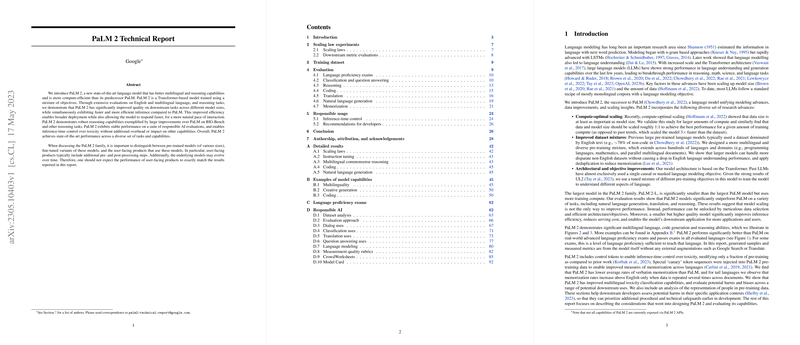An Insightful Overview of the PaLM 2 Technical Report
The "PaLM 2 Technical Report" by Google introduces PaLM 2, a state-of-the-art LLM built using a Transformer-based architecture. The key highlights of PaLM 2 include improved multilingual capabilities, enhanced reasoning abilities, and superior computational efficiency compared to its predecessor, PaLM. This essay aims to summarize the major aspects of PaLM 2, emphasizing its architecture, training methodologies, evaluation results, and implications for future AI research and applications.
Model Architecture and Training
PaLM 2 is developed as a Transformer-based LLM, with several sizes including small, medium, and large variants. Notably, PaLM 2 incorporates findings from compute-optimal scaling, which suggest that data and model size should be scaled approximately 1:1 to achieve optimal performance for a given amount of training compute. This contrasts with past trends that scaled model size more aggressively than the dataset size.
The training corpus for PaLM 2 is diverse, including multilingual text, parallel multilingual documents, code, mathematics, and conversational data. The emphasis on non-English data allows PaLM 2 to handle multilingual tasks with increased proficiency. The training data is significantly larger and more diverse compared to that of PaLM, enabling PaLM 2 to advance multilingual and domain-specific capabilities without compromising its performance on English tasks.
Architecture and Objective Improvements
PaLM 2 integrates architectural improvements, leveraging insights from the UL2 framework, which entails using a mixture of pre-training objectives to enhance language understanding. This mixture approach allows the model to capture different aspects of language comprehensively. The architecture is refined to balance model size and training compute, ensuring efficient inference and broader deployment possibilities.
One notable aspect is the optimization for higher context lengths, making PaLM 2 adept at handling tasks that require long-range comprehension, like extended dialogues and long-form summation.
Evaluation Results
The evaluation of PaLM 2 encompasses a variety of benchmarks, focusing on core capabilities such as classification, question answering (QA), reasoning, code generation, translation, and natural language generation (NLG). Across these benchmarks, PaLM 2 consistently outperforms PaLM and shows competitive results against other state-of-the-art models like GPT-4.
Classification and QA
PaLM 2 exhibits significant improvements on standard English QA and classification tasks and performs exceptionally well on multilingual QA datasets like TyDi QA. It shows robust performance on multilingual toxicity classification tasks using the Jigsaw multilingual dataset, indicating its strong capabilities in handling nuanced and sensitive language tasks across different languages.
Reasoning
On reasoning tasks, PaLM 2 surpasses PaLM and achieves competitive results on datasets such as BIG-Bench Hard, MATH, GSM8K, and XCOPA. The integration of chain-of-thought prompting and self-consistency methods further enhances its performance on complex reasoning tasks.
Code Generation
PaLM 2 demonstrates significant code generation capabilities, outperforming PaLM-540B-Coder on benchmarks like HumanEval, MBPP, and ARCADE. Its proficiency in handling multiple programming languages, including low-resource languages like Haskell and Julia, is particularly noteworthy.
Translation
PaLM 2's translation capabilities are evaluated using the WMT21 and FRMT benchmarks. It shows significant improvements over PaLM and the Google Translate production system. The multilingual evaluation underscores PaLM 2’s ability to produce translations that respect regional dialects and reduce potential misgendering harms.
Natural Language Generation
The NLG evaluation covers datasets like XLSum, WikiLingua, and XSum, demonstrating PaLM 2's ability to generate high-quality text across a variety of languages and domains. The model's superior performance in generating coherent and contextually appropriate responses showcases its advanced generative capabilities.
Implications and Future Developments
The robustness and versatility of PaLM 2 across multiple languages, reasoning tasks, and domains have significant implications for both practical applications and theoretical research in AI. The model's efficient architecture and multilingual proficiency make it a valuable tool for developing AI applications that cater to a global audience.
Future research for PaLM 2 could explore refining the model's adaptability to specific downstream tasks through fine-tuning and prompt-tuning techniques. Additionally, addressing ethical considerations and evaluating potential harms in application-specific contexts will be crucial for responsible deployment.
Conclusion
The PaLM 2 Technical Report provides comprehensive insights into the advancements made in developing a state-of-the-art LLM. PaLM 2’s superior performance, multilingual capabilities, and efficient architecture mark significant progress in the field of AI, paving the way for innovative applications and further research in developing robust, multilingual, and ethically informed AI systems.
